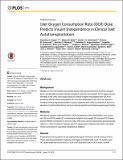Islet Oxygen Consumption Rate (OCR) Dose Predicts Insulin Independence in Clinical Islet Autotransplantation
Author(s)
Papas, Klearchos K.; Bellin, Melena D.; Sutherland, David E. R.; Suszynski, Thomas M.; Kitzmann, Jennifer P.; Avgoustiniatos, Efstathios S.; Gruessner, Angelika C.; Mueller, Kathryn R.; Beilman, Gregory J.; Balamurugan, Appakalai N.; Loganathan, Gopalakrishnan; Colton, Clark K.; Koulmanda, Maria; Weir, Gordon C.; Wilhelm, Josh J.; Qian, Dajun; Niland, Joyce C.; Hering, Bernhard J.; ... Show more Show less
DownloadPapas-2015-Islet Oxygen Consump.pdf (707.4Kb)
PUBLISHER_CC
Publisher with Creative Commons License
Creative Commons Attribution
Terms of use
Metadata
Show full item recordAbstract
Background
Reliable in vitro islet quality assessment assays that can be performed routinely, prospectively, and are able to predict clinical transplant outcomes are needed. In this paper we present data on the utility of an assay based on cellular oxygen consumption rate (OCR) in predicting clinical islet autotransplant (IAT) insulin independence (II). IAT is an attractive model for evaluating characterization assays regarding their utility in predicting II due to an absence of confounding factors such as immune rejection and immunosuppressant toxicity.
Methods
Membrane integrity staining (FDA/PI), OCR normalized to DNA (OCR/DNA), islet equivalent (IE) and OCR (viable IE) normalized to recipient body weight (IE dose and OCR dose), and OCR/DNA normalized to islet size index (ISI) were used to characterize autoislet preparations (n = 35). Correlation between pre-IAT islet product characteristics and II was determined using receiver operating characteristic analysis.
Results
Preparations that resulted in II had significantly higher OCR dose and IE dose (p<0.001). These islet characterization methods were highly correlated with II at 6–12 months post-IAT (area-under-the-curve (AUC) = 0.94 for IE dose and 0.96 for OCR dose). FDA/PI (AUC = 0.49) and OCR/DNA (AUC = 0.58) did not correlate with II. OCR/DNA/ISI may have some utility in predicting outcome (AUC = 0.72).
Conclusions
Commonly used assays to determine whether a clinical islet preparation is of high quality prior to transplantation are greatly lacking in sensitivity and specificity. While IE dose is highly predictive, it does not take into account islet cell quality. OCR dose, which takes into consideration both islet cell quality and quantity, may enable a more accurate and prospective evaluation of clinical islet preparations.
Date issued
2015-08Department
Massachusetts Institute of Technology. Department of Chemical EngineeringJournal
PLOS ONE
Publisher
Public Library of Science
Citation
Papas, Klearchos K., Melena D. Bellin, David E. R. Sutherland, Thomas M. Suszynski, Jennifer P. Kitzmann, Efstathios S. Avgoustiniatos, Angelika C. Gruessner, et al. “Islet Oxygen Consumption Rate (OCR) Dose Predicts Insulin Independence in Clinical Islet Autotransplantation.” Edited by Matthias G von Herrath. PLoS ONE 10, no. 8 (August 10, 2015): e0134428.
Version: Final published version
ISSN
1932-6203